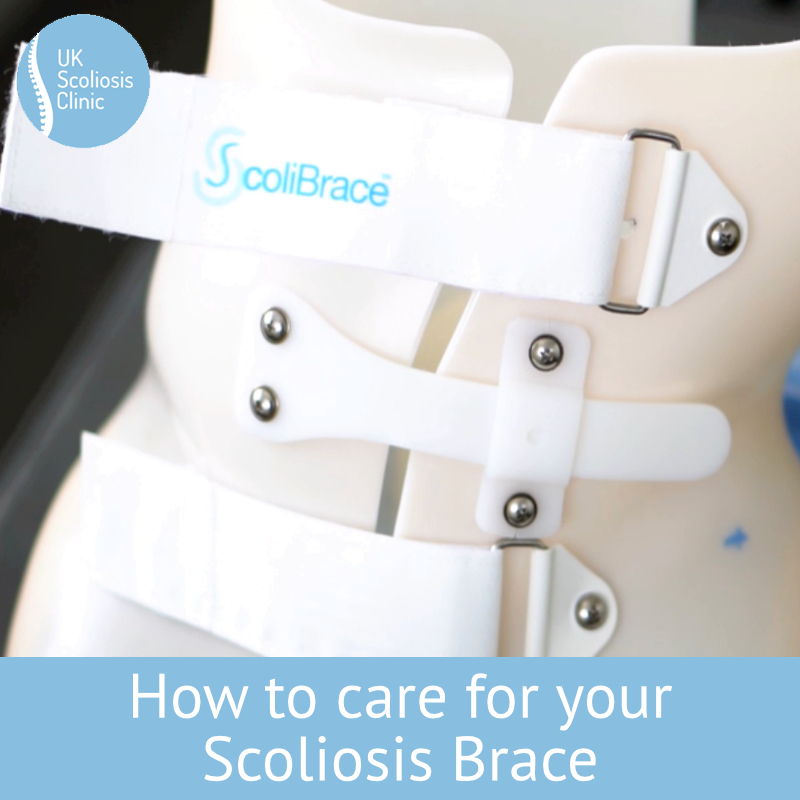
Modern Scoliosis braces are designed to be durable and to last for a long time – indeed, if you’re an adult being fitted for a brace, we’d like to think it should last you a lifetime. However, caring for your brace is important, and poor brace care is one of the reasons that they sometimes need to be replaced.
It goes without saying that braces made for children & adolescents do tend to take more wear and tear and often this is OK since most children will go through several braces during treatment – however, wherever possible it’s best to prolong the life of a brace as much as possible, not least to avoid the cost of replacing a brace which was otherwise effective! Here are some tips for good brace care.
Keep the Brace Clean
The first and most important step in caring for a scoliosis brace is to keep it clean. You should clean the brace at least once a week, but more often if it gets sweaty or dirty. Use a mild soap and warm water to clean the brace, making sure to rinse it thoroughly to remove any soap residue. Avoid using harsh chemicals or abrasive cleaners, as these can damage the brace. Once you’ve cleaned the brace, let it air dry completely before wearing it again.
Store the Brace Properly
When you’re not wearing your scoliosis brace, it’s important to store it properly to prevent damage. Keep the brace in a cool, dry place, away from direct sunlight and heat sources as much as possible. Avoid storing the brace in a damp or humid area, as this can cause it to mould or mildew. You may also want to consider using a brace hanger or stand to keep it upright and prevent it from becoming misshapen.
Avoid Extremes Of Temperature
Modern day plastic braces are designed to be light, stiff, not retain heat and be strong. This in turn imposes a challenge in plastic construction, in that the brace may not like being subjected to sudden changes in temperature in going from hot to cold, where the pastic may be weakened. So it would be wise to avoid sitting directly in front of a hot fire and then going out and rolling around in the snow.
Wear the brace correctly
When putting your brace on, make sure you adjust any straps or fittings as directed by your specialist – braces are designed to work properly when set up correctly and are strongest when worn properly. Improperly wearing a brace especially when it is too loose, can reduce its effectiveness and possibly lead to additional wear and tear over time.
Avoid Overexertion
While a scoliosis brace can help support your spine and patients are encouraged to do as many activities as they can whilst wearing it, it’s important to avoid overexertion when wearing it. Activities that involve bending, twisting, or lifting heavy objects can put extra strain on the brace and cause it to wear out faster. If you’re unsure about whether a certain activity is safe to do while wearing your brace, ask your specialist.
Check for Wear and Tear
Regularly inspect your scoliosis brace for signs of wear and tear, such as cracks, tears, or fraying. If you notice any damage, stop wearing the brace immediately and consult your specialist. Wearing a damaged brace can be dangerous and may not provide the support your spine needs. Most damage to braces is easy enough to repair – but if left unattended the brace may need to be replaced.
Wear a Bodysock Or Vest Underneath the Brace
Wearing a bodysock, seamless vest or shirt under your brace can help prevent skin irritation, but it also helps to stop your brace from getting sweaty. The garment should be seamless, made from a soft, breathable material, such as cotton or bamboo, and should fit snugly but not be too tight. Avoid wearing synthetic fabrics or clothing with rough seams, as these can rub against the skin and cause irritation.
Have any problems fixed
If any part of your brace is uncomfortable or doesn’t seem to be sitting quite right, get in touch and have it checked out right away. This is especially true if your brace has just been adjusted – even a small nagging issue will make you hesitant to wear the brace and might end up reducing your wear time and treatment effectiveness.


